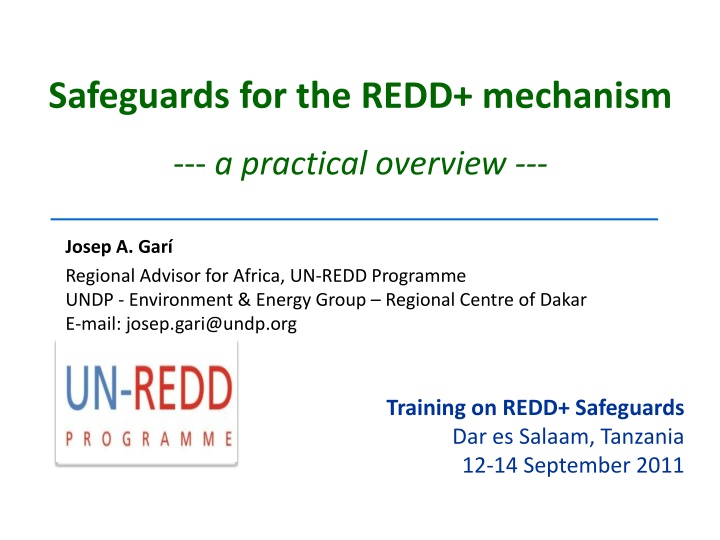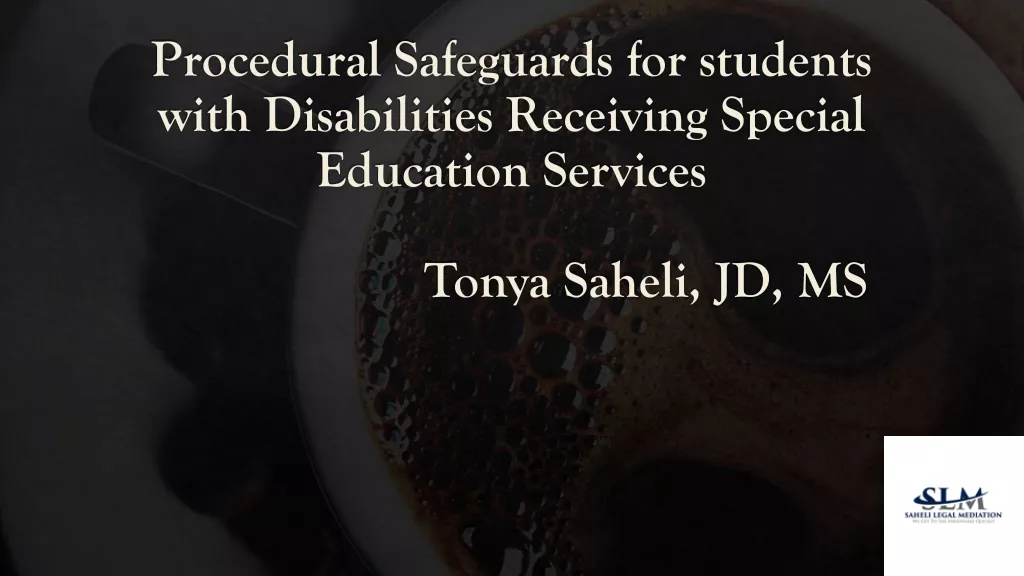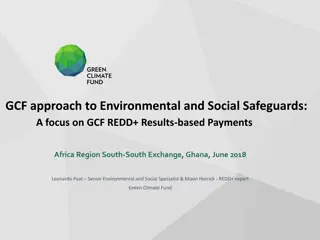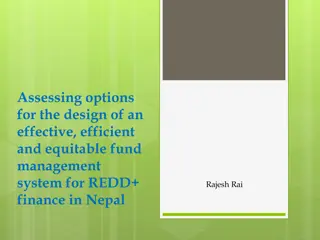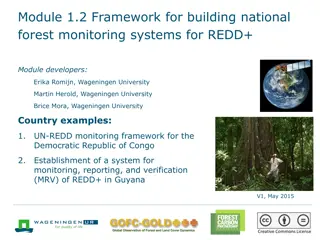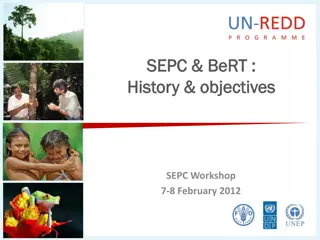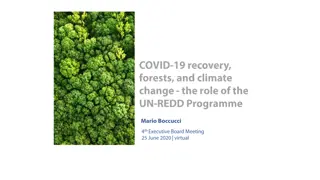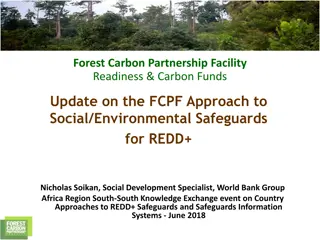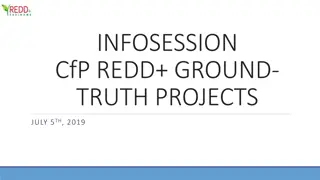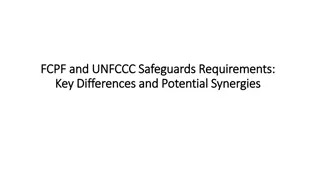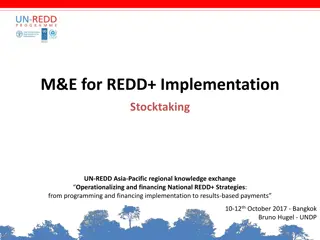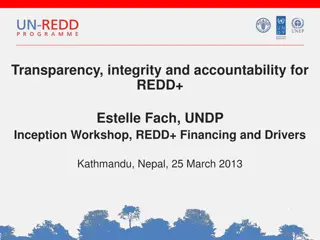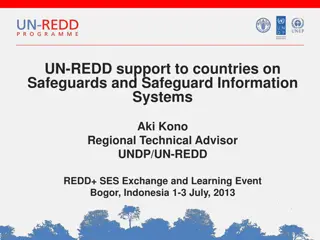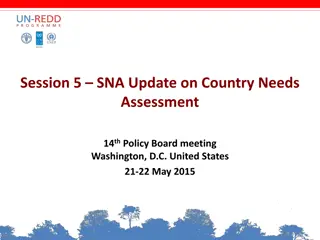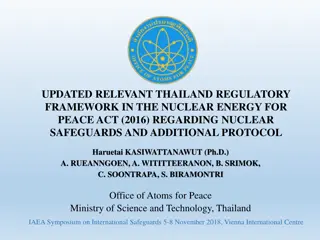Safeguards for the REDD+ mechanism
The REDD+ mechanism aims to compensate efforts to reduce GHG emissions from deforestation. Safeguards play a crucial role in preventing undesirable outcomes by encompassing various measures like policies, risk management tools, and monitoring schemes. With a focus on social and environmental safeguards, issues such as human rights protection, stakeholder participation, and habitat preservation are addressed to ensure the sustainable implementation of REDD+ projects.
Download Presentation

Please find below an Image/Link to download the presentation.
The content on the website is provided AS IS for your information and personal use only. It may not be sold, licensed, or shared on other websites without obtaining consent from the author.If you encounter any issues during the download, it is possible that the publisher has removed the file from their server.
You are allowed to download the files provided on this website for personal or commercial use, subject to the condition that they are used lawfully. All files are the property of their respective owners.
The content on the website is provided AS IS for your information and personal use only. It may not be sold, licensed, or shared on other websites without obtaining consent from the author.
E N D
Presentation Transcript
Safeguards for the REDD+ mechanism --- a practical overview --- Josep A. Gar Regional Advisor for Africa, UN-REDD Programme UNDP - Environment & Energy Group Regional Centre of Dakar E-mail: josep.gari@undp.org Training on REDD+ Safeguards Dar es Salaam, Tanzania 12-14 September 2011
The REDD+ mechanism Intends to compensate demonstrable efforts to reduce GHG emissions from deforestation and forest degradation (to protect forests to note the 5 core REDD+ activities) How the REDD+ mechanism is designed and implemented is crucial (in terms of both the international policy and national process) REDD+ provides a unique opportunity for forest conservation & development finance, but entails risks. hence safeguards are required
What safeguards are ... A set of measures to prevent undesirable outcomes of policies and programmes. Such measures can encompass policies, procedures, actions, risk management tools, monitoring schemes, etc. --- up to creativity Prevent + monitoring + correct & redress
A diversity of language Principles Standards Criteria Safeguards [term retained in the Cancun Agreements] Risk mitigation measures Strategic social & environmental assessments Precautionary measures
two major types of safeguards Social safeguards Environmental safeguards
Social safeguards (examples of issues to consider and address) Protection and realisation of human and social rights Stakeholder participation, including forest peoples, FPIC Equality (socio-economic, gender, cultural/identity) Social inclusion Fair REDD+ distribution mechanisms Avoiding involuntary resettlement Democratic governance Transparency & anti-corruption measures Enhancement of rural livelihoods Et cetera ...
Environmental safeguards (examples of issues to consider and address) Protecting natural habitats Avoiding conversion of natural forests to other land uses Use of indigenous species in reforestation programmes Ensure and capture multiple benefits (beyond carbon), Avoid displacement Avoidance of reversals Fostering green development, Promote biodiversity conservation Implement international environmental agreements Et cetera ...
two levels for building REDD+ safeguards I. International policy framework Cancun Agreements (2010) in Appendix I New protocol will define & endorse REDD+ safeguards note: tension between need of safeguards and national sovereignty (text of Cancun Agreements reads: safeguards should be promoted and supported )
two levels for building REDD+ safeguards II. National safeguards system for REDD+ Each country will craft their own safeguards, in conformity with the international policy framework National safeguards system to be credible & approved at international level (to be defined how) Safeguards built under cross-stakeholder consensus and to be operative
two considerations development practice, despite well-intentioned efforts, has sometimes negative and unintended effects ---> safeguards are critically needed YET excessive zeal and control devices in development practice may halt or disrupt actions, innovations and transformations, thus perpetuating existing problems ---> safeguards need to be operational and realist
Safeguards & / versus multiple benefits Due Diligence Social Environmental Due Diligence Multiple benefits minimum standards Both can be integrated in the same system the country to decide. The Cancun Agreements mix both (but unevenly).
Designing and implementing safeguards Phase 1 (REDD+ readiness): Safeguards are designed together with the overall design of the REDD+ mechanism (with the strategy, and as part of the REDD+ implementation mechanism). Some testing desirable (e.g. pilot projects) Phase 2 (REDD+ investments and reforms): Safeguards are implemented and fully tested (hence improved, if needed) Phase 3 (REDD+ system operational): Safeguards fully operational.
Cancun Agreements (2010) --- Appendix I --- When undertaking activities referred to in paragraph 70 of this decision, the following safeguards should be promoted and supported:
Cancun Agreements (Appendix I) ( / ) (a) Actions complement or are consistent with the objectives of national forest programmes and relevant international conventions and agreements; (b) Transparent and effective national forest governance structures, taking into account national legislation and sovereignty; (.../...)
Cancun Agreements (Appendix I) ( / ) (c) Respect for the knowledge and rights of indigenous peoples and members of local communities, by taking into account relevant international obligations, national circumstances and laws, and noting that the United Nations General Assembly has adopted the United Nations Declaration on the Rights of Indigenous Peoples; (d) The full and effective participation of relevant stakeholders, in particular, indigenous peoples and local communities, in actions referred to in paragraphs 70 and 72 of this decision; ( / )
Cancun Agreements (Appendix I) ( / ) (e) Actions are consistent with the conservation of natural forests and biological diversity, ensuring that actions referred to in paragraph 70 of this decision are not used for the conversion of natural forests, but are instead used to incentivize the protection and conservation of natural forests and their ecosystem services, and to enhance other social and environmental benefits; (f) Actions to address the risks of reversals; (g) Actions to reduce displacement of emissions.
some considerations for country-level efforts to building safeguards (i) Every country has specific social & environmental conditions, issues, dynamics and risks ---> safeguards shall be country-specific and may differ among countries Need to make emphasis in relevant and critical risks Use existing tools and systems when building safeguards (e.g. social & environmental impact assessments policies and devices, international standards and safeguards guidelines and toolkits) Inputs and insights from the field are crucial (avoid a desk-based exercise only)
some considerations for country-level efforts to building safeguards (ii) Need to be able to update safeguards mechanisms: e.g. if conditions change, if some issues become more problematic than anticipated, if some safeguards are impractical to monitor/enforce Building safeguards is a policy and operational exercise, part of the development practice i.e. not an academic endeavour. There is risk of political capture or manipulation of safeguards work. Safeguards, if well designed and implemented, enhance enormously the development practice.
thank you for the attention do not hesitate to ask asking & discussing is part of the methods for building safeguards
